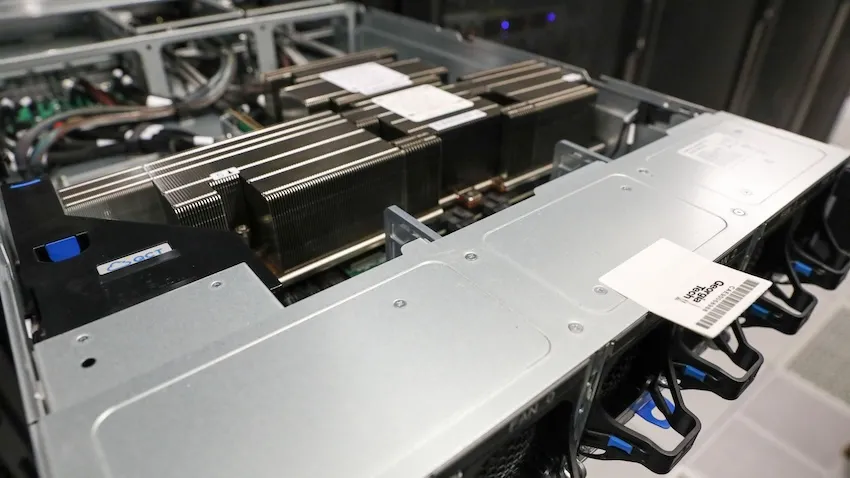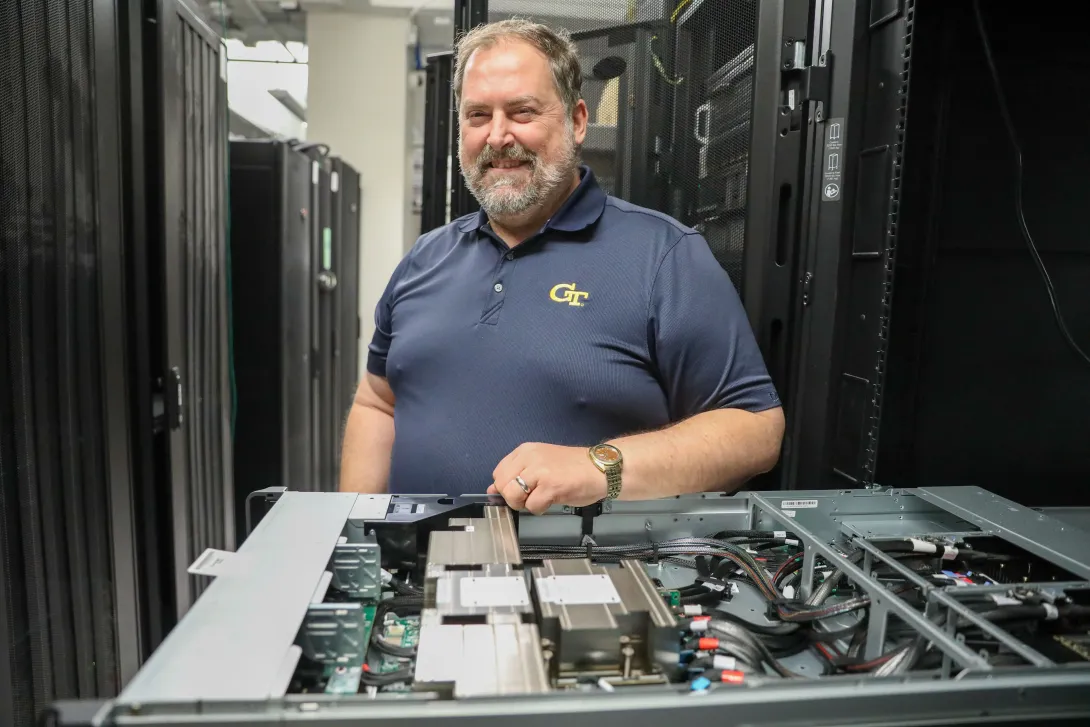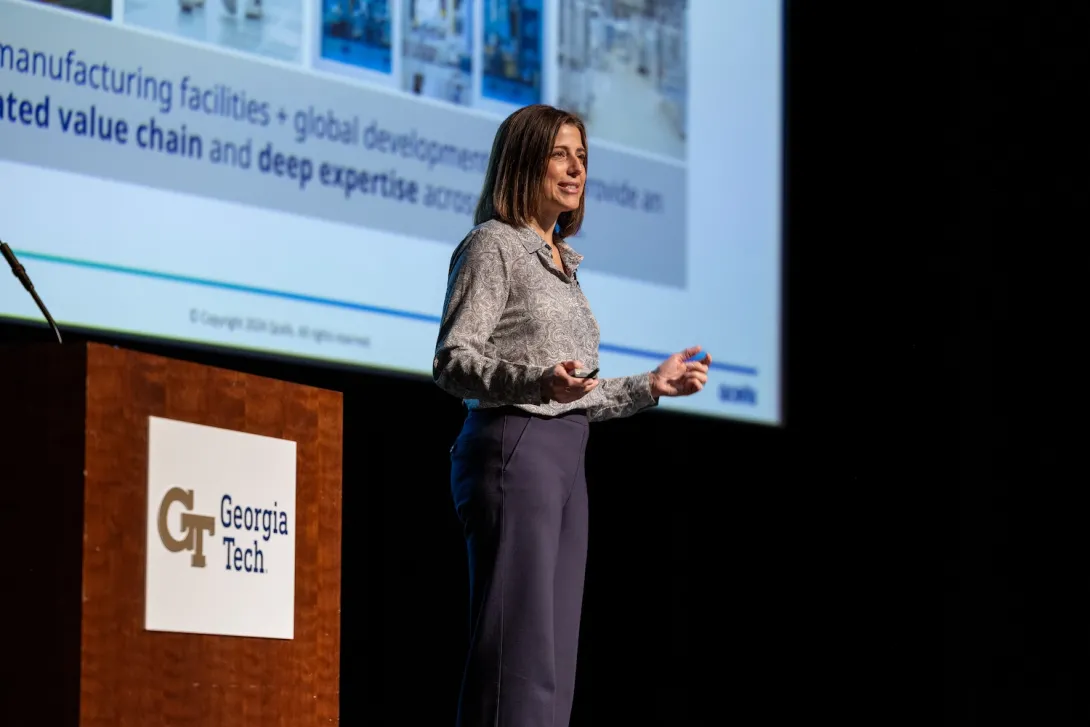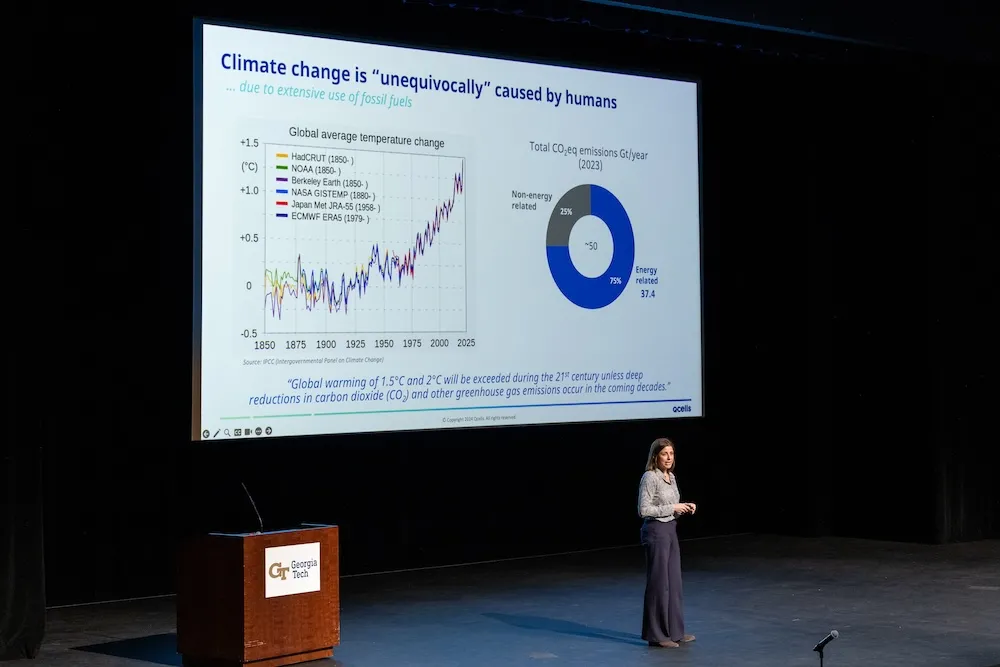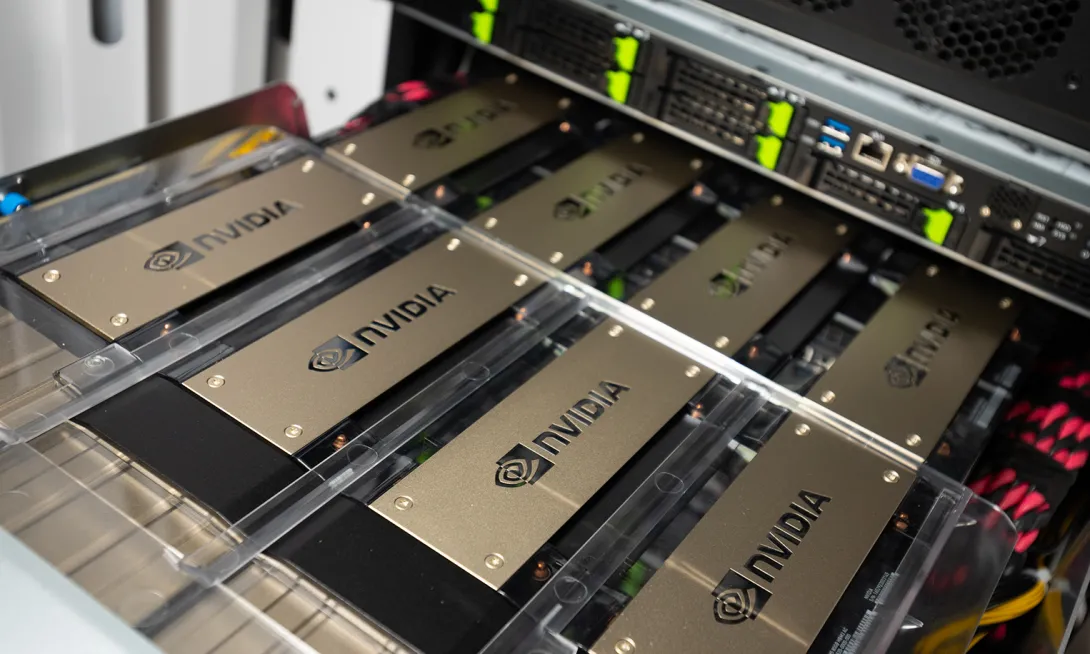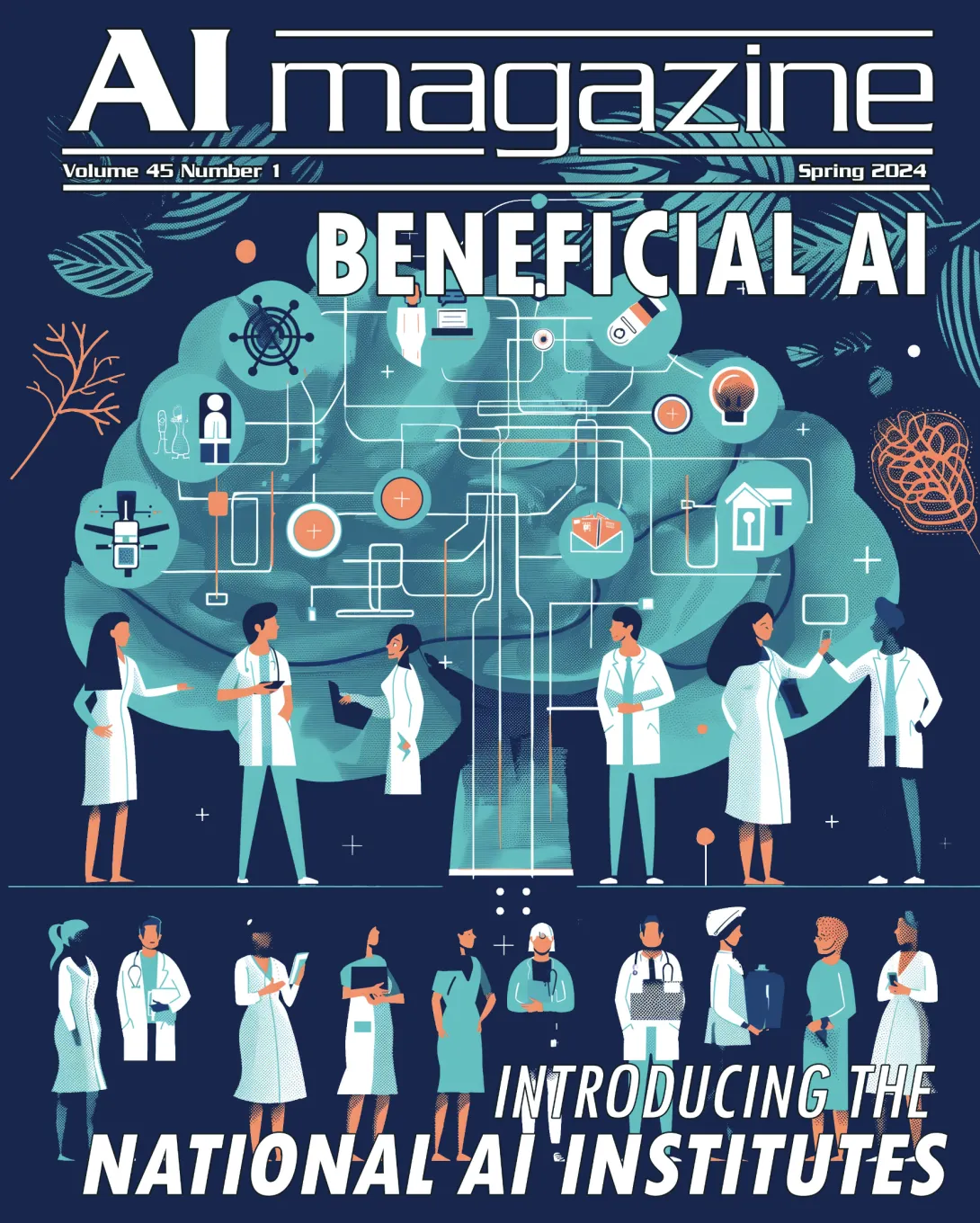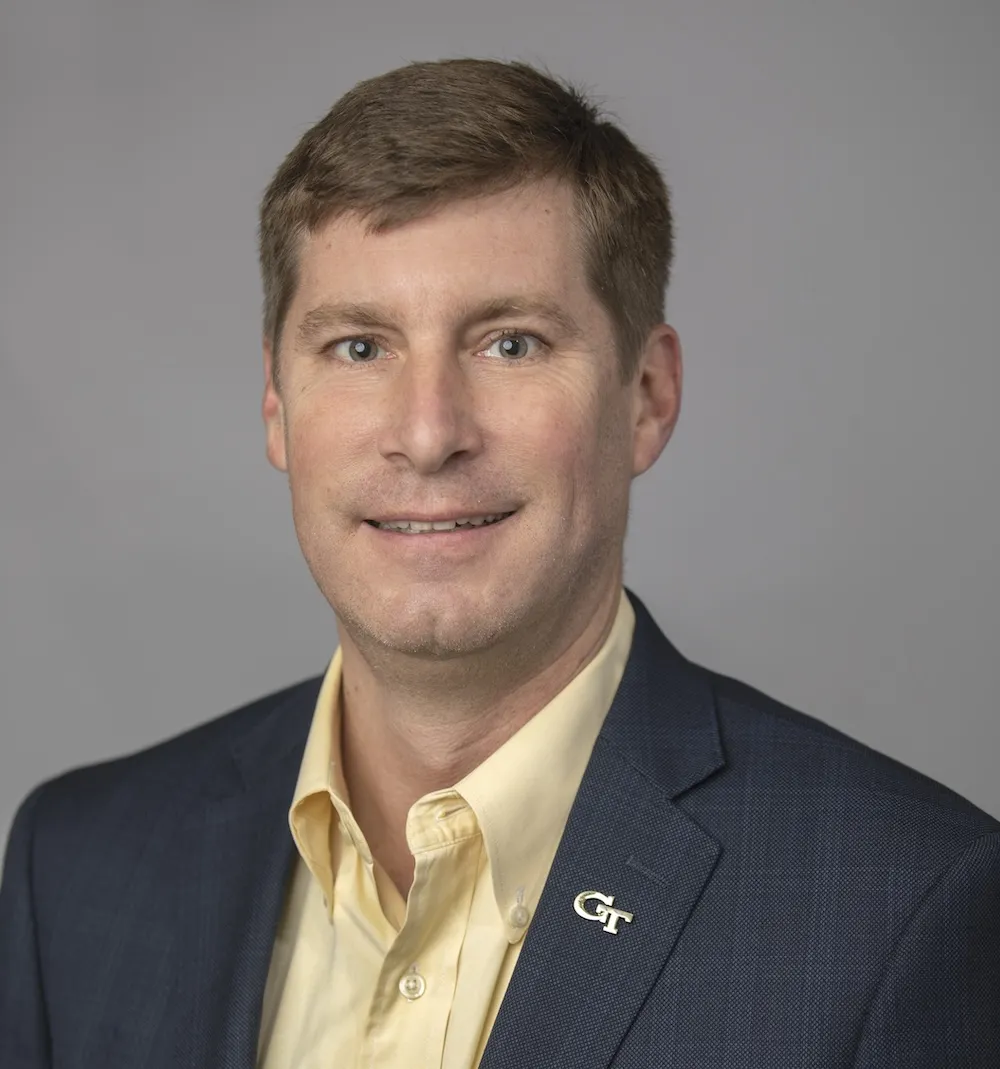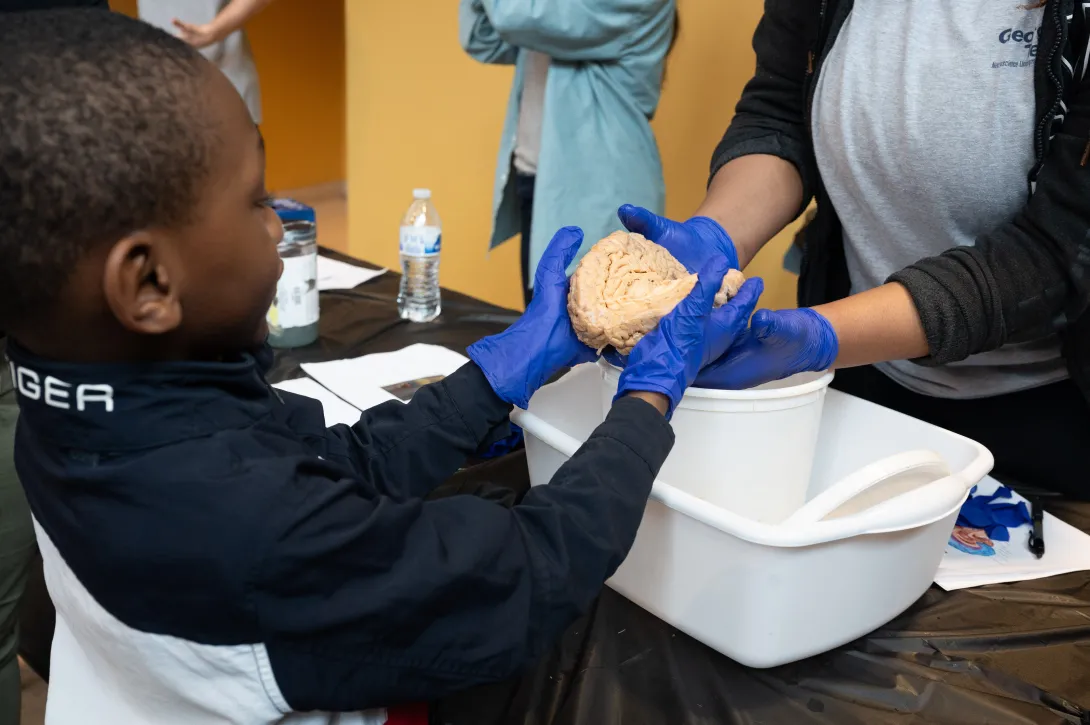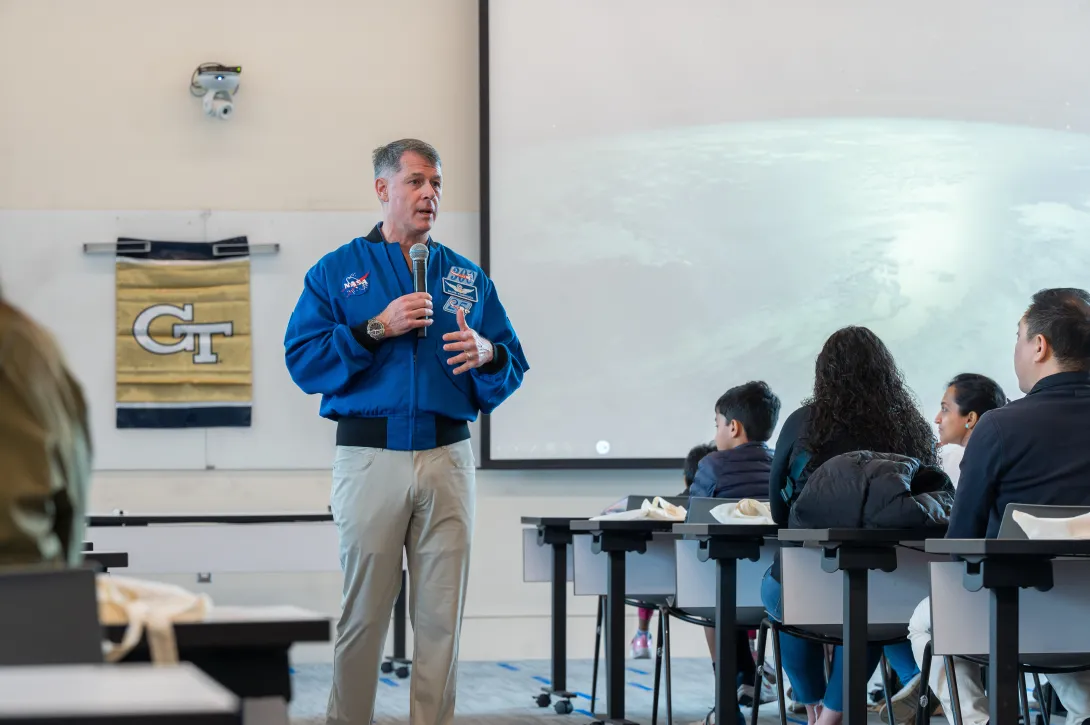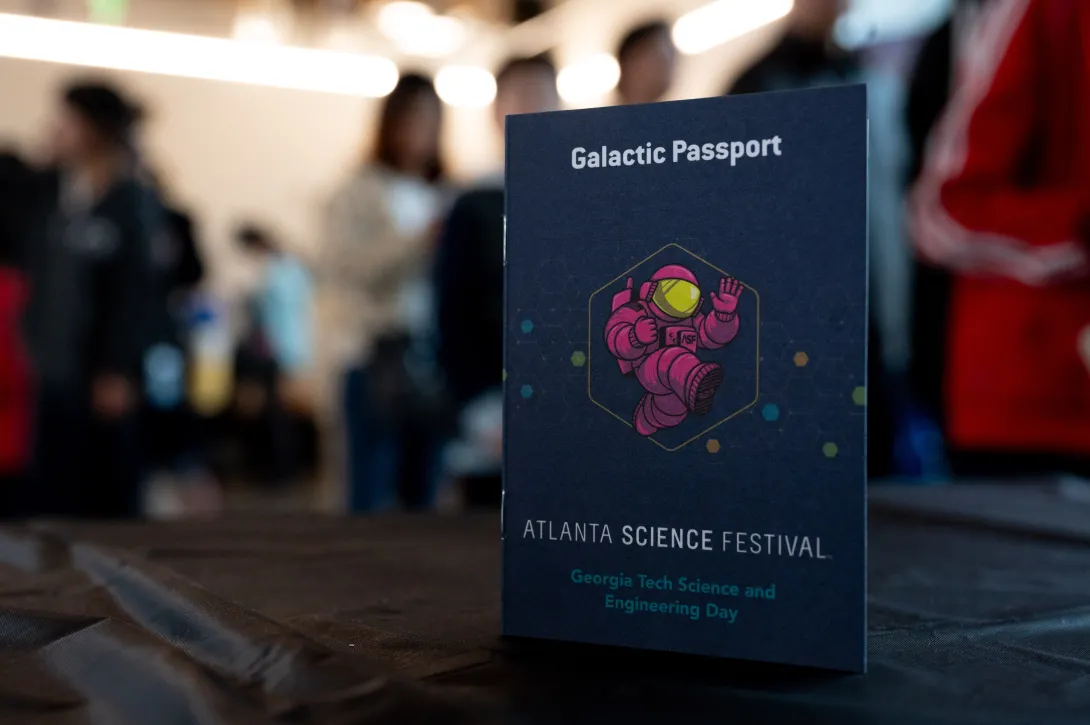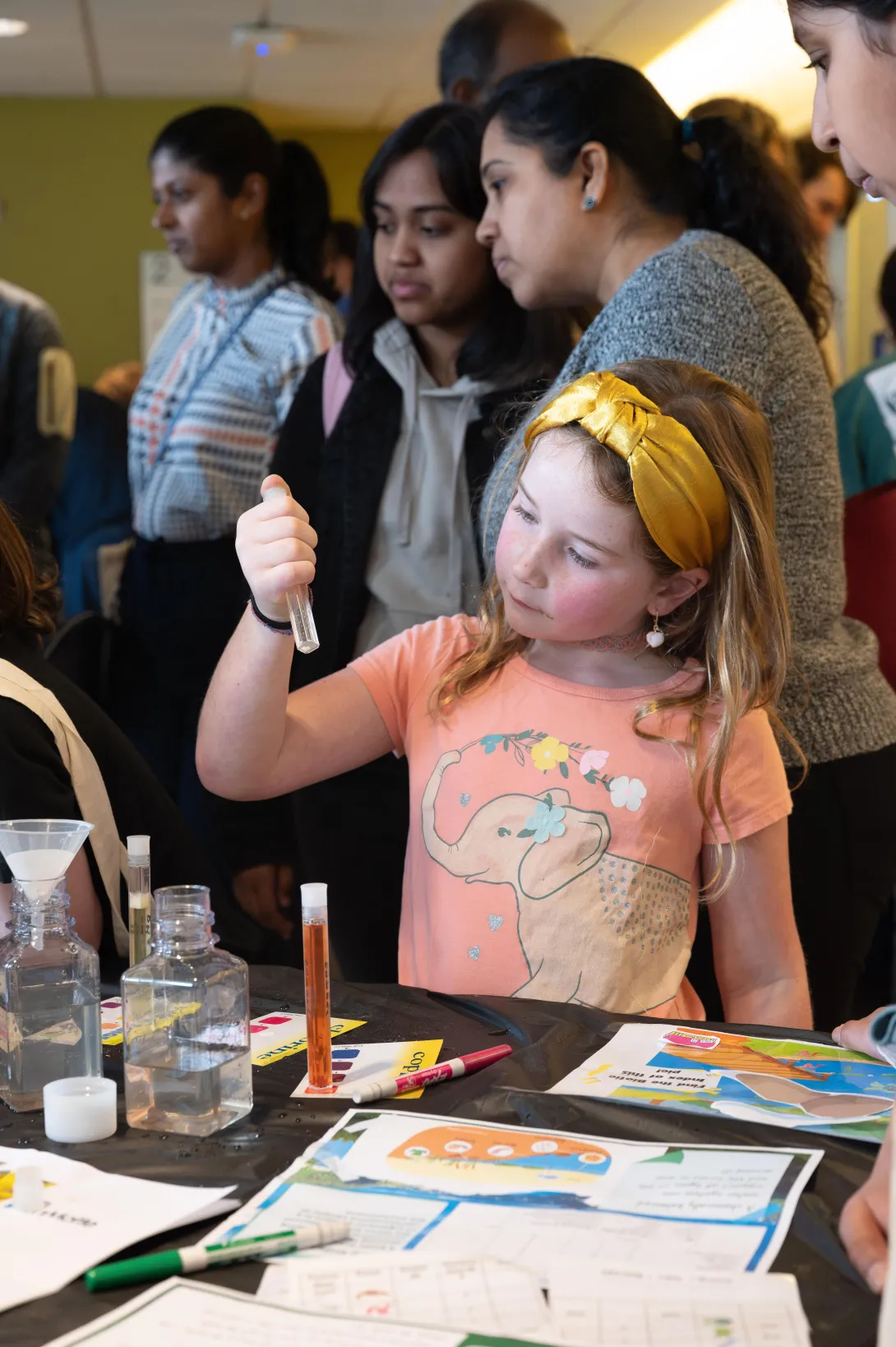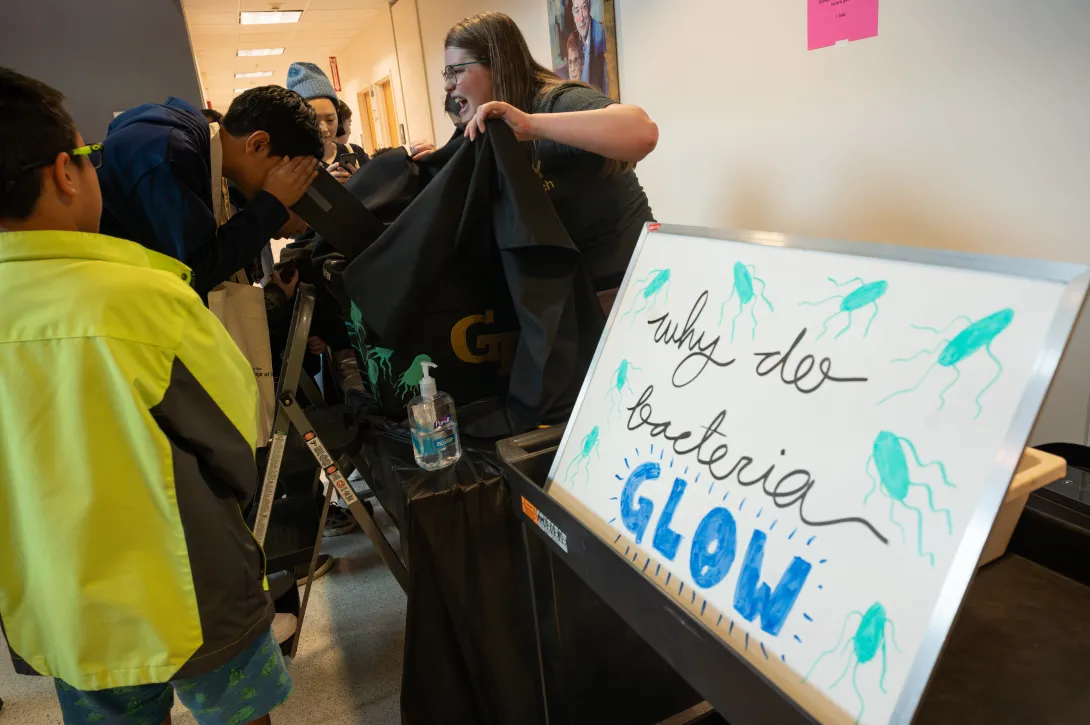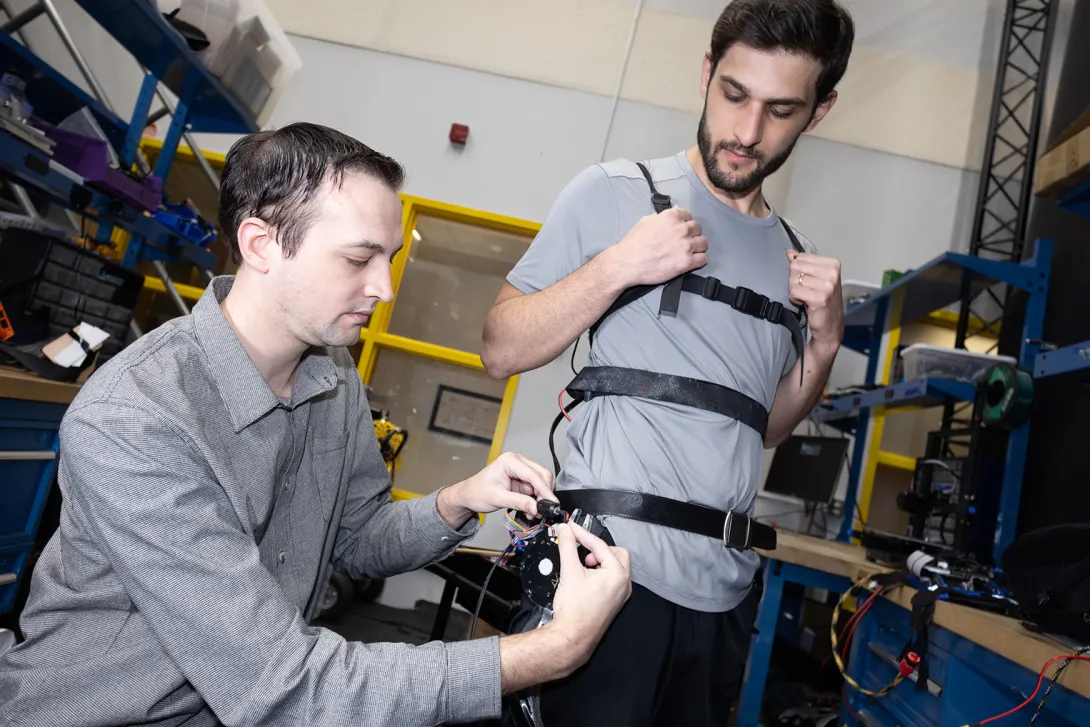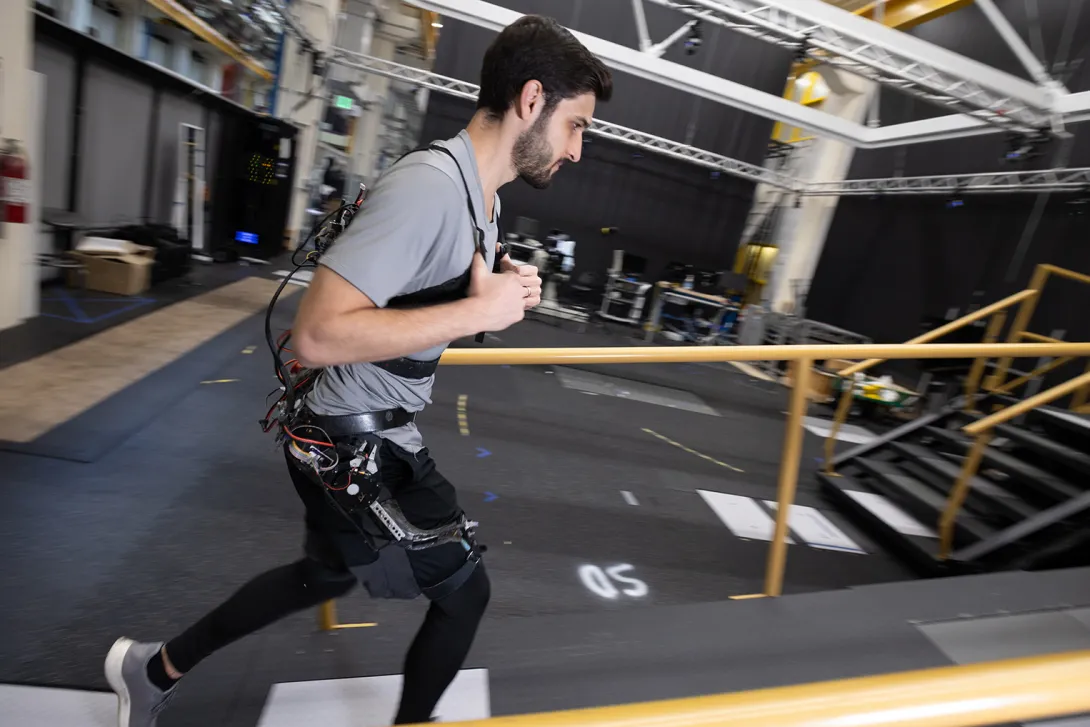Apr. 19, 2024
Metz, France
Three-dimensional (3D) hetero-integration technology is set to transform the field of electronics. Vertically stacking functional layers, creates novel 2D-3D circuit architectures with high integration density and unprecedented multifunctionality.
Three researchers at Georgia Tech-CNRS IRL 2958, a joint international research laboratory based at Georgia Tech-Europe in Metz, France, were among a team that demonstrated cutting-edge 2D/single-crystalline 3D/2D (2D/C-3D/2D) Integration using a precise layer splitting technique to overcome drawbacks in ferroelectric materials use in electrostatic capacitors.
Abdallah Ougazzaden, professor of Electrical and Computer Engineering at Georgia Tech, and president of Georgia Tech-Europe, Phuong Vuong, Georgia Tech-CNRS IRL 2958 researcher, and Suresh Sundaram, adjunct faculty in Georgia Tech’s School of Electrical and Computer Engineering, are co-authors on an April 19, 2024 research article in the journal, Science, entitled “High energy density in artificial heterostructures through relaxation time modulation.”
Ferroelectric materials used in electrostatic capacitors have unique advantages such as maximum polarization due to their higher electric susceptibilities related to dielectric constants, or permittivity, a measure of a material’s ability to store electrical energy. However, their high remnant polarization, the amount of polarization that remains in the material after the electric field is removed, limits how well they can store and release energy during the discharging process.
In the Science article, researchers demonstrated an innovative approach that sandwiches a single crystalline BTO (C-BTO) layer with 2D materials in the form of a freestanding membrane and effectively suppresses the remnant polarization of ferroelectric materials while maintaining the maximum polarization.
This ultra-thin vertical stacking technology was achieved using three different two-dimensional materials in combination with single crystalline BTO (C-BTO). Hexagonal boron nitride semiconductor was developed in the International Research Laboratory at GT-Europe, while graphene, and Molybdenum disulfide (MoS2) were developed at MIT.
These new 2D material technologies have a special type of bonding called van der Waals forces. On account of this, the layers can be easily separated to create components without needing any chemical etching or cutting processes.
“The 2D hexagonal boron nitride (h-BN) material that we are developing at Georgia Tech-CNRS IRL 2958 on large surfaces using the MOCVD epitaxial growth technique has demonstrated its significant potential in emerging technologies across various domains such as future quantum computers, biotechnology, flexible electronics, sensors, energy, and optogenetics.” said Ougazzaden, head of the h-BN project at Georgia Tech-CNRS IRL 2958,” adding, “We are currently working on some of these applications, and we hope to produce even more results and demonstrate new achievements."
Electrostatic capacitors, with their ability to store and release electrical energy quickly, find a wide range of applications across various fields of electronics and electrical engineering for energy storage, power conditioning etc.
In a similar collaboration, the same research team from Georgia Tech-CNRS IRL 2958 published a paper in December 2023, showing the first demonstration of the monolithic 3D integration of an artificial intelligence (AI) processor using two-dimensional (2D) materials.
This innovative integration approach combined six layers of transistor and memristor networks into a 3D nano-system. By stacking nanoscale materials made from 2D materials using bottom-up technology, the team created a fully integrated AI system.
The monolithic 3D method significantly improved processing efficiency by reducing time, voltage drops, latency, and footprint. In addition to offering a solution for electronic hetero-integration with 2D materials, broke new ground for advanced multifunctional processors and systems for AI applications and complex computing.
The team’s results on vertical hetero-integration were published in the scientific journal, Nature Materials, entitled, "Monolithic 3D Integration of 2D Materials-Based Electronics towards Ultimate Edge Computing Solutions.”
The researchers who contributed to the Science article discovered that when ferroelectric materials are combined in special structures (like 2D/C-3D/2D layers), it affects how much leftover charge a capacitor has and how well it can store energy. These insights will advance designs of high-energy capacitors using these materials. In the future, this could lead to more efficient and powerful energy storage systems.
Apr. 17, 2024
Computing research at Georgia Tech is getting faster thanks to a new state-of-the-art processing chip named after a female computer programming pioneer.
Tech is one of the first research universities in the country to receive the GH200 Grace Hopper Superchip from NVIDIA for testing, study, and research.
Designed for large-scale artificial intelligence (AI) and high-performance computing applications, the GH200 is intended for large language model (LLM) training, recommender systems, graph neural networks, and other tasks.
Alexey Tumanov and Tushar Krishna procured Georgia Tech’s first pair of Grace Hopper chips. Spencer Bryngelson attained four more GH200s, which will arrive later this month.
“We are excited about this new design that puts everything onto one chip and accessible to both processors,” said Will Powell, a College of Computing research technologist.
“The Superchip’s design increases computation efficiency where data doesn’t have to move as much and all the memory is on the chip.”
A key feature of the new processing chip is that the central processing unit (CPU) and graphics processing unit (GPU) are on the same board.
NVIDIA’s NVLink Chip-2-Chip (C2C) interconnect joins the two units together. C2C delivers up to 900 gigabytes per second of total bandwidth, seven times faster than PCIe Gen5 connections used in newer accelerated systems.
As a result, the two components share memory and process data with more speed and better power efficiency. This feature is one that the Georgia Tech researchers want to explore most.
Tumanov, an assistant professor in the School of Computer Science, and his Ph.D. student Amey Agrawal, are testing machine learning (ML) and LLM workloads on the chip. Their work with the GH200 could lead to more sustainable computing methods that keep up with the exponential growth of LLMs.
The advent of household LLMs, like ChatGPT and Gemini, pushes the limit of current architectures based on GPUs. The chip’s design overcomes known CPU-GPU bandwidth limitations. Tumanov’s group will put that design to the test through their studies.
Krishna is an associate professor in the School of Electrical and Computer Engineering and associate director of the Center for Research into Novel Computing Hierarchies (CRNCH).
His research focuses on optimizing data movement in modern computing platforms, including AI/ML accelerator systems. Ph.D. student Hao Kang uses the GH200 to analyze LLMs exceeding 30 billion parameters. This study will enable labs to explore deep learning optimizations with the new chip.
Bryngelson, an assistant professor in the School of Computational Science and Engineering, will use the chip to compute and simulate fluid and solid mechanics phenomena. His lab can use the CPU to reorder memory and perform disk writes while the GPU does parallel work. This capability is expected to significantly reduce the computational burden for some applications.
“Traditional CPU to GPU communication is slower and introduces latency issues because data passes back and forth over a PCIe bus,” Powell said. “Since they can access each other’s memory and share in one hop, the Superchip’s architecture boosts speed and efficiency.”
Grace Hopper is the inspirational namesake for the chip. She pioneered many developments in computer science that formed the foundation of the field today.
Hopper invented the first compiler, a program that translates computer source code into a target language. She also wrote the earliest programming languages, including COBOL, which is still used today in data processing.
Hopper joined the U.S. Navy Reserve during World War II, tasked with programming the Mark I computer. She retired as a rear admiral in August 1986 after 42 years of military service.
Georgia Tech researchers hope to preserve Hopper’s legacy using the technology that bears her name and spirit for innovation to make new discoveries.
“NVIDIA and other vendors show no sign of slowing down refinement of this kind of design, so it is important that our students understand how to get the most out of this architecture,” said Powell.
“Just having all these technologies isn’t enough. People must know how to build applications in their coding that actually benefit from these new architectures. That is the skill.”
News Contact
Bryant Wine, Communications Officer
bryant.wine@cc.gatech.edu
Apr. 16, 2024
There is an expectation that implementing new and emerging Generative AI (GenAI) tools enhances the effectiveness and competitiveness of organizations. This belief is evidenced by current and planned investments in GenAI tools, especially by firms in knowledge-intensive industries such as finance, healthcare, and entertainment, among others. According to forecasts, enterprise spending on GenAI will increase by two-fold in 2024 and grow to $151.1 billion by 2027.
However, the path to realizing return on these investments remains somewhat ambiguous. While there is a history of efficiency and productivity gains from using computers to automate large-scale routine and structured tasks across various industries, knowledge and professional jobs have largely resisted automation. This stems from the nature of knowledge work, which often involves tasks that are unstructured and ill-defined. The specific input information, desired outputs, and/or the processes of converting inputs to outputs in such tasks are not known a priority, which consequently has limited computer applications in core knowledge tasks.
GenAI tools are changing the business landscape by expanding the range of tasks that can be performed and supported by computers, including idea generation, software development, and creative writing and content production. With their advanced human-like generative abilities, GenAI tools have the potential to significantly enhance the productivity and creativity of knowledge workers. However, the question of how to integrate GenAI into knowledge work to successfully harness these advantages remains a challenge. Dictating the parameters for GenAI usage via a top-down approach, such as through formal job designs or redesigns, is difficult, as it has been observed that individuals tend to adopt new digital tools in ways that are not fully predictable. This unpredictability is especially pertinent to the use of GenAI in supporting knowledge work for the following reasons.
Continue reading: How Different Fields Are Using GenAI to Redefine Roles
Reprinted from the Harvard Business Review, March 25, 2024
Maryam Alavi is the Elizabeth D. & Thomas M. Holder Chair & Professor of IT Management, Scheller College of Business, Georgia Institute of Technology.
News Contact
Lorrie Burroughs
Apr. 16, 2024
More than 400 people participated in Energy Materials Day on March 27, as researchers and industry leaders came together to discuss and advance energy materials technologies such as solar energy, carbon-neutral fuels, and batteries.
Energy materials are the things — natural, manufactured, or both — that aid the use of energy. They also play a key role in developing cleaner, more efficient energy solutions.
Energy Materials Day was co-hosted by Georgia Tech’s Strategic Energy Institute (SEI), the Institute for Materials (IMat), and the Georgia Tech Advanced Battery Center. The event evolved out of last year’s Georgia Tech Battery Day.
“As an engine of innovation in science and technology, Georgia Tech has incredible opportunities and the responsibility to conduct research to benefit society,” said Chaouki Abdallah, executive vice president for Research at Georgia Tech. “We call this ‘research that matters.’”
Events like Energy Materials Day are part of an ongoing, long-range effort to position Georgia Tech, and Georgia, as a go-to location for modern energy companies. Tech was recently ranked by U.S. News & World Report as the top public university for energy research. Abdallah also outlined why Georgia Tech, with more than 1,000 researchers across campus working in the energy space, is a natural fit for events that foster collaboration between the public and private sectors.
“Right here, right now, we have the opportunity to harness our collective powers, our collective knowledge, our collective resources to become a global engine of innovation,” he said.
Plenary speaker Danielle Merfeld, global chief technology officer at QCells, highlighted opportunities for the current and future clean energy infrastructure in the United States.
"At the heart of our discussions today [are these questions]: What is new technology, and how do you make it ... and make it at scale, in an affordable, accessible, and reliable way?” she said.
"... [The] good news is this country has taken a very deliberate step toward creating the most robust industrial policy we've had in decades. ... This is driving opportunity and creating the foundation for manufacturing. So, [we can] use that industrial base of making and consuming power [and] decarbonize the electric grid by 2035...."
“Events like this are so important to forwarding progress in research and industry,” said Eric Vogel, IMat’s executive director. “It’s important to bring together professionals throughout the industry to keep these lines of communication open.”
The day was divided into three tracks: battery materials and technologies, photovoltaics and the grid, and materials for carbon-neutral fuel production. Attendees were encouraged to listen to talks from all three areas. Each track included academic speakers who shared their research and private-sector speakers who described how technological advancements are affecting the industry.
“With its rich history in energy research, Georgia Tech remains a leader in addressing global energy challenges,” said Tim Lieuwen, executive director of SEI. “The success of Energy Materials Day is encouraging, and I eagerly anticipate continuing these discussions in 2025.”
News Contact
Amelia Neumeister
Research Communications Program Manager
Apr. 11, 2024
Georgia Tech’s College of Engineering has established an artificial intelligence supercomputer hub dedicated exclusively to teaching students. The initiative — the AI Makerspace — is launched in collaboration with NVIDIA. College leaders call it a digital sandbox for students to understand and use AI in the classroom
Initially focusing on undergraduate students, the AI Makerspace aims to democratize access to computing resources typically reserved for researchers or technology companies. Students will access the cluster online as part of their coursework, deepening their AI skills through hands-on experience. The Makerspace will also better position students after graduation as they work with AI professionals and help shape the technology’s future applications.
“The launch of the AI Makerspace represents another milestone in Georgia Tech’s legacy of innovation and leadership in education,” said Raheem Beyah, dean of the College and Southern Company Chair. “Thanks to NVIDIA’s advanced technology and expertise, our students at all levels have a path to make significant contributions and lead in the rapidly evolving field of AI.”
News Contact
Jason Maderer, College of Engineering
Apr. 02, 2024
Georgia Tech is supporting career growth for its research faculty, who do critical work at the heart of the research enterprise.
The word faculty is often synonymous with tenure-track professors — the individuals who teach courses and run major labs with their surnames in the title. But while groundbreaking discoveries regularly happen at Georgia Tech, the people doing the day-in, day-out research aren’t always visible.
Research faculty are non-tenure track faculty who carry out crucial research in labs, centers, and departments across campus. They are the lifeblood of research enterprises at major universities like Georgia Tech, but their work often occurs behind the scenes.
To support these essential employees, Georgia Tech launched an initiative to recognize and develop research faculty, who comprise 60% of the nearly 4,400 total faculty currently employed at the Institute. It is part of the second phase of Research Next, the strategic plan for Georgia Tech’s research enterprise.
Maribeth Coleman, interim assistant vice provost for Research Faculty, and Michelle Rinehart, vice provost for Faculty, were appointed as co-chairs of a Research Next implementation team tasked with finding ways to recognize, support, and retain research faculty. Building on years of effort and collaboration with campus partners, the group took on several projects to improve the research faculty experience and environment at Georgia Tech.
“Research faculty are critical members of the Georgia Tech community, and their contributions to our billion-dollar research enterprise and the state’s economic development cannot be overstated,” Rinehart said. “We wanted to understand what it’s like for research faculty as they come on board at Georgia Tech, what the hiring process is like, and how we as an Institute can more effectively mentor and develop research faculty in terms of advancing in their careers.”
At the outset, the implementation team identified and examined several facets of the research faculty experience. They reviewed policies in the faculty handbook, giving special attention to existing guidance for promotion and career growth for research faculty.
Promotion guidelines are generally clear for tenure-track faculty. Research faculty, on the other hand, are often not actively encouraged to seek promotion, and may not even know that promotion is an option, according to Rinehart and Coleman. One issue is that funding for research faculty often comes from external research dollars. At least nine months of a tenure-track faculty member’s salary, however, comes from the state budget.
“When you’re constantly having to bring in all of your own salary, as research faculty do, it can be a stressful experience,” Coleman said. “It can also mean you’re more isolated, because you’re focused on bringing in those research dollars that will help you keep your position. But we want research faculty to know that we want them to build their careers here.”
To address these issues, the team developed reference materials and workshops for research faculty seeking promotion. The workshops are offered on a regular basis, and resources and recordings are available on the Georgia Tech faculty website. The team also created educational materials for promotion committees, often composed of tenure-track faculty who are unfamiliar with the research faculty experience.
“We saw a need for better consistency across campus with regards to guidance for research faculty promotion committees,” Rinehart said. “Tenure-track faculty need guidance on not just how to properly hire research faculty, but also in how to mentor and retain them.”
According to Coleman and Rinehart, the implementation team’s most significant achievement was the launch of a research faculty mentoring network. The mentoring network connects junior research faculty mentees with senior research faculty mentors who have grown their careers at Georgia Tech.
“When new tenure-track faculty arrive, they are usually assigned a mentor within their School or department, but that method doesn’t generally work for research faculty,” Coleman said. “There may not be a large research faculty community in their unit, and research faculty roles and responsibilities vary significantly from person to person. For this reason, the mentoring network is meant to foster cross-pollination and build community across units.”
The mentoring network is a collaboration with MentorTech, a program run by Georgia Tech Professional Education. The program is ongoing, and enrollment is always open.
To foster inclusivity and belonging, the team established an orientation program for research faculty, modeled after the tenure-track faculty orientation. The Provost’s Office hosted the inaugural research faculty orientation in Fall 2023. Because research faculty are hired throughout the year, the team decided the orientation should take place semiannually. The second orientation took place on March 13.
In addition to the workshops, mentor network, and orientations, the implementation team also launched a program to welcome research faculty in a personal way. When a new research faculty member is hired, another more senior research faculty member is assigned to welcome them in person, provide them with important information for getting oriented to campus, tell them about relevant professional opportunities, and give them Georgia Tech-branded swag.
“All of this work is about recognizing that research faculty are a tremendously valuable part of our community,” Rinehart said. “They also really enhance our reputation internationally.”
According to Coleman, research faculty can sometimes be viewed as disposable, because of their support from grants that may be limited in time and scope. But she believes that line of thinking is a disservice to both the individual and the Institute.
“It’s important that we recognize the value of research faculty, nurture them, and retain them long term,” she said. “We need to make it possible for people to spend their careers here, as I have, and help make sure research faculty positions at Georgia Tech can be both viable and fulfilling long-term careers.”
To read more about Georgia Tech's strategic research initiatives, visit the Research Next website.
Mar. 28, 2024
The Association for the Advancement of Artificial Intelligence released its Spring 2024 special issue of AI Magazine (Volume 45, Issue 1). This issue highlights research areas, applications, education initiatives, and public engagement led by the National Science Foundation (NSF) and USDA-NIFA-funded AI Research Institutes. It also delves into the background of the NSF’s National AI Research Institutes program, its role in shaping U.S. AI research strategy, and its future direction. Titled “Beneficial AI,” this issue showcases various AI research domains, all geared toward implementing AI for societal good.
The magazine, available as open access at https://onlinelibrary.wiley.com/toc/23719621/2024/45/1, a one-year effort, spearheaded and co-edited by Ashok Goel, director of the National AI-ALOE Institute and professor of computer science and human-centered computing at Georgia Tech, along with Chaohua Ou, AI-ALOE’s managing director and assistant director, Special Projects and Educational Initiatives Center for Teaching and Learning (CTL) at Georgia Tech, and Jim Donlon, the NSF's AI Institutes program director.
In this issue, insights into the future of AI and its societal impact are presented by the three NSF AI Institutes headquartered at Georgia Tech:
- AI-ALOE: National AI Institute for Adult Learning and Online Education
- Introduction to the Special Issue by Ashok Goel and Chaohua Ou.
- The magazine features AI-ALOE’s work in reskilling, upskilling, and workforce development, showcasing how AI is reshaping adult learning and online education to prepare our workforce for the future.
- AI4OPT: AI Institute for Advances in Optimization
- An overview of AI4OPT’s efforts in combining AI and optimization to tackle societal challenges in various sectors. The institute aims to create AI-assisted optimization systems for efficiency improvements, uncertainty quantification, and sustainability challenges, while also offering educational pathways in AI for engineering.
- AI-CARING: National AI Institute for Collaborative Assistance and Responsive Interaction for Networked Groups
- AI-CARING’s section in the magazine details its comprehensive approach to using AI technologies to address the complex needs of aging adults, while navigating ethical considerations and promoting education in the field.
- Co-authors contributing to AI-CARING's section include Sonia Chernova, associate professor at Georgia Tech and director of AI-CARING, along with members Elizabeth Mynatt, Agata Rozga, Reid Simmons, and Holly Yanco, all involved in AI-CARING research and education.
The magazine provides a comprehensive overview of how each of the 25 institutes is shaping the future of AI research.
About 'AI Magazine'
AI Magazine is an artificial intelligence magazine by the Association for the Advancement of Artificial Intelligence (AAAI). It is published four times each year, and is sent to all AAAI members and subscribed to by most research libraries. Back issues are available online (issues less than 18 months old are only available to AAAI members).
The purpose of AI Magazine is to disseminate timely and informative articles that represent the current state of the art in AI and to keep its readers posted on AAAI-related matters. The articles are selected to appeal to readers engaged in research and applications across the broad spectrum of AI. Although some level of technical understanding is assumed by the authors, articles should be clear enough to inform readers who work outside the particular subject area.
To learn more, click here.
News Contact
Breon Martin
AI Research Communications Manager
Georgia Tech
Mar. 26, 2024
Jud Ready, a principal research engineer at the Georgia Tech Research Institute (GTRI), has been selected to join the National Academy of Inventors’ (NAI) 2024 Class of Senior Members – a group of 124 academic inventors from NAI’s Member Institutions who have made significant contributions to innovation and technology.
Holding a dual appointment as Deputy Director of Innovation Initiatives for Georgia Tech’s Institute for Materials, one of Tech’s 10 Interdisciplinary Research Institutes (IRI) focused on advancing materials research and innovation, and with over two decades of experience as an adjunct professor in Tech’s School of Materials Science & Engineering, Ready has established himself as a leader in materials science and engineering.
Read the full story
News Contact
Michelle Gowdy
(Interim) Director of Communications, GTRi
Mar. 21, 2024
Georgia Tech opened the 11th annual Atlanta Science Festival (ASF) with record attendance for Science and Engineering Day. Despite the drizzly weather, about 4,000 people of all ages from throughout metro Atlanta — more than double the number of attendees in 2023 — visited campus on Saturday, March 9, 2024, for the space-themed event. They explored more than 45 exhibitions and hands-on activities related to art, robotics, nanotechnology, chemical and systems engineering, and biology, as well as other STEAM areas.
Visitors began their investigations at “Earth” (the Kendeda Building for Innovative Sustainable Design), where they picked up a galactic passport specially designed to guide them from building to building — each designated with the name of a planet — and the demonstrations housed within.
At “Mars” (Marcus Nanotechnology Building), attendees measured their height in nanometers, experimented with fruit batteries, and took a window-tour of the largest cleanroom in the Southeast, where semiconductors are developed. Inside “Venus” (Parker H. Petit Biotech Building), budding scientists examined bioluminescent bacteria under a microscope and made Play-Doh models of the human brain. When visiting “Saturn” (Ford Environmental Sciences and Technology Building), visitors studied density by making DIY lava lamps and inspected human brain specimens the way a pathologist would.
“Getting to hold a human brain was cool,” said a 12-year-old participant from Alpharetta. “And I also liked comparing it to the brains of a pig and a mouse.”
Other activities included math games and puzzles, the opportunity to build an artificial hand and a gallery display of research-inspired artwork. Georgia Tech faculty, students, and staff hosted all the demonstrations and served as volunteers who helped Science and Engineering Day guests navigate campus and the demonstration sites.
For many participants, the undoubted highlight was the chance to hear a presentation by former NASA astronaut and Georgia Tech alumnus Shane Kimbrough, MS OR 1998. Kimbrough spent 388 days in space over three missions and served as commander of the International Space Station (ISS) in 2016. He captivated the standing-room-only crowd with photos and descriptions of his time living and working aboard the ISS and answered questions from the kids in the audience.
“It’s really exciting to see all the activities around campus today … we’re inspiring the next generation of scientists and explorers for our country,” Kimbrough said afterward.
The event was a resounding success for Georgia Tech and the Atlanta Science Fair.
Lauren Overton-Kirk, who organized the event for the Institute, said, "Georgia Tech Science and Engineering Day 2024 was so wonderful to share with the community. What started years ago as a day for young scientific exploration became an all-ages, space-themed scientific spectacular. You could feel the passion for learning fill the campus in a way only Georgia Tech could do.”
Both the Georgia Tech and the Atlanta Science Festival teams are looking forward to next year’s Science and Engineering Day.
“As one of the founding organizations of the Atlanta Science Festival, Georgia Tech has been deeply invested in sharing the Institute’s innovations with the community,” said Meisa Salaita, ASF co-director. “And that investment was deeply evident on March 9th as they opened their doors to kick off the 11th annual Science Festival. Their students and faculty came out with enthusiasm to showcase science to the public. We couldn't be more thrilled with this partnership — and the many ways Tech has helped us show our community that Atlanta is a science city.”
News Contact
Shelley Wunder-Smith, Institute Communications
Mar. 20, 2024
Robotic exoskeletons designed to help humans with walking or physically demanding work have been the stuff of sci-fi lore for decades. Remember Ellen Ripley in that Power Loader in Alien? Or the crazy mobile platform George McFly wore in 2015 in Back to the Future, Part II because he threw his back out?
Researchers are working on real-life robotic assistance that could protect workers from painful injuries and help stroke patients regain their mobility. So far, they have required extensive calibration and context-specific tuning, which keeps them largely limited to research labs.
Mechanical engineers at Georgia Tech may be on the verge of changing that, allowing exoskeleton technology to be deployed in homes, workplaces, and more.
A team of researchers in Aaron Young’s lab have developed a universal approach to controlling robotic exoskeletons that requires no training, no calibration, and no adjustments to complicated algorithms. Instead, users can don the “exo” and go.
Their system uses a kind of artificial intelligence called deep learning to autonomously adjust how the exoskeleton provides assistance, and they’ve shown it works seamlessly to support walking, standing, and climbing stairs or ramps. They described their “unified control framework” March 20 in Science Robotics.
“The goal was not just to provide control across different activities, but to create a single unified system. You don't have to press buttons to switch between modes or have some classifier algorithm that tries to predict that you're climbing stairs or walking,” said Young, associate professor in the George W. Woodruff School of Mechanical Engineering.
News Contact
Joshua Stewart
College of Engineering

